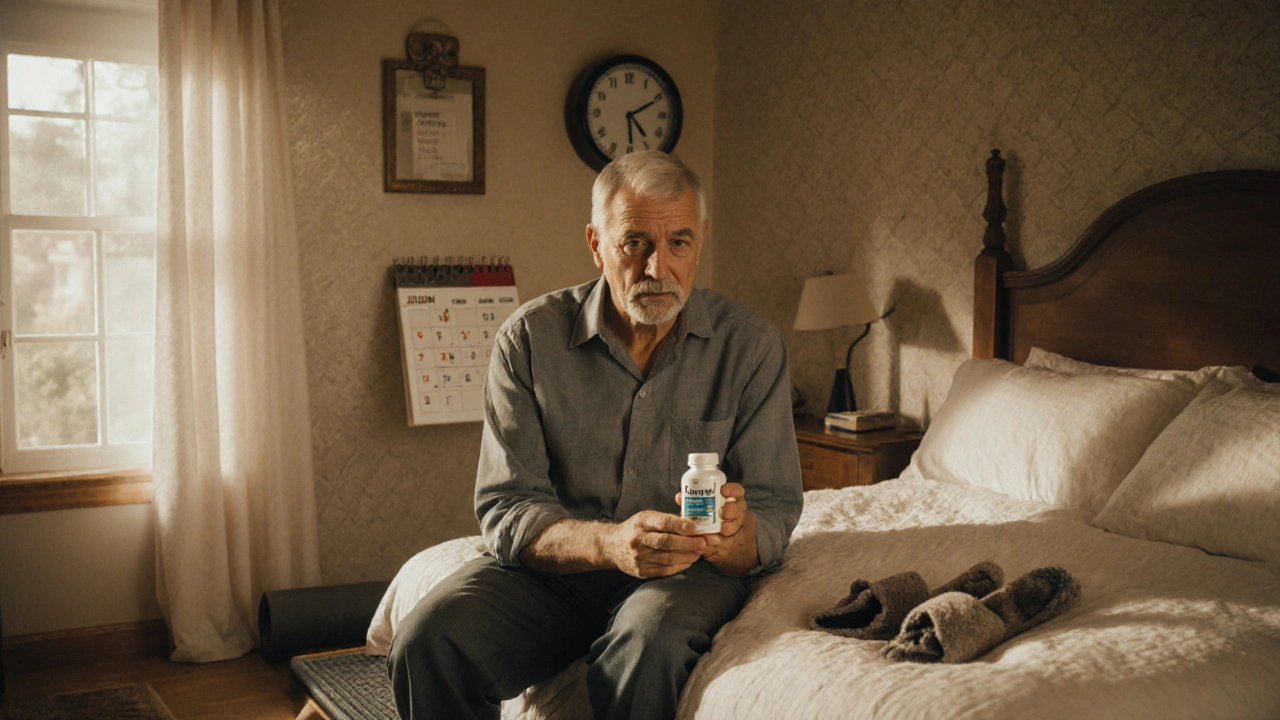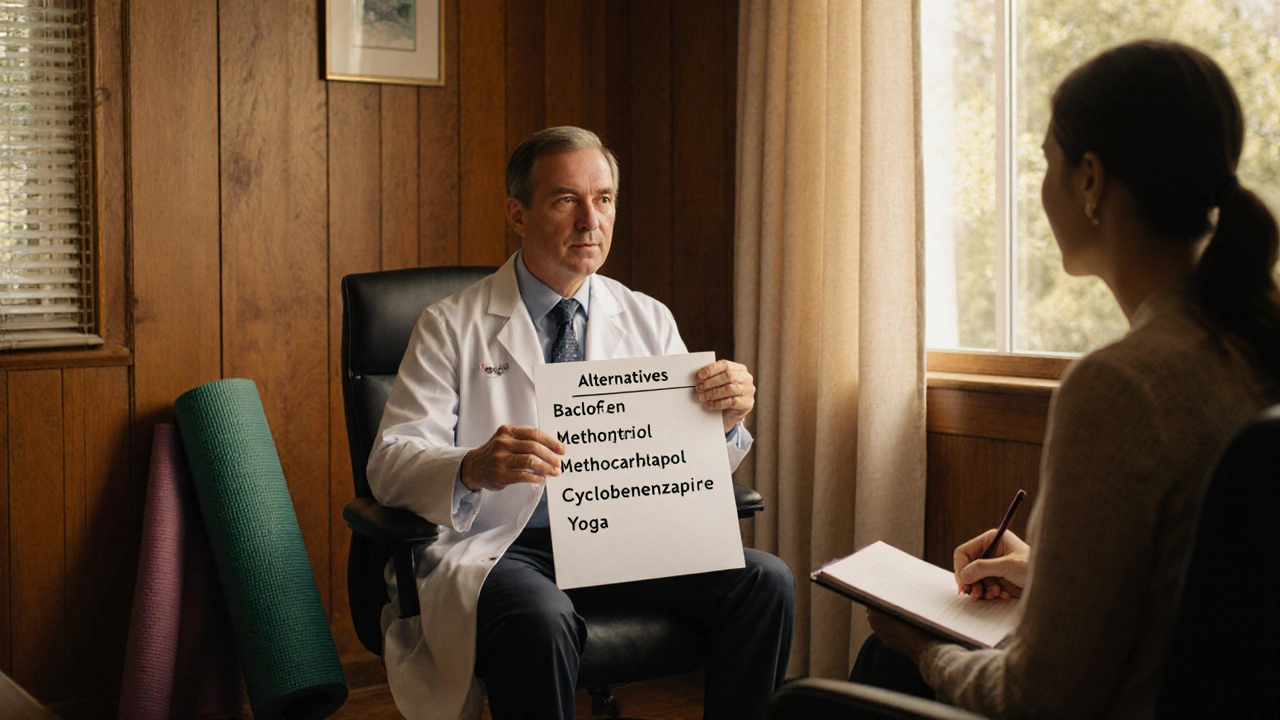Compare Zanaflex (Tizanidine) with Alternatives for Muscle Spasm Relief
 Oct, 28 2025
Oct, 28 2025
When muscle spasms hit hard, Zanaflex (tizanidine) can feel like a lifeline. But if it’s not working, causing drowsiness, or just too expensive, you’re not alone in asking: what else works? Many people switch to other muscle relaxants hoping for the same relief without the side effects. This isn’t just about swapping pills-it’s about matching the right drug to your body, lifestyle, and what’s actually causing the spasms.
How Zanaflex (Tizanidine) Actually Works
Zanaflex is a short-acting muscle relaxant that targets the central nervous system, not the muscles themselves. It works by activating alpha-2 receptors in the spinal cord, which reduces the signals that cause muscles to tighten up. That’s why it’s often prescribed for spasms from multiple sclerosis, spinal cord injuries, or severe back pain.
The effects kick in within 1 to 2 hours and last about 3 to 6 hours. That means you might need to take it 3 to 4 times a day. It’s not meant for daily, long-term use. Most doctors recommend it for short flare-ups because of how it affects your brain-drowsiness, dizziness, and low blood pressure are common. About 20% of users report feeling too tired to drive or work after taking it.
Alternative 1: Baclofen
Baclofen is the most common alternative to Zanaflex, especially for people with neurological conditions like MS or cerebral palsy. Like tizanidine, it works on the spinal cord, but it targets GABA-B receptors instead. That gives it a slightly different effect profile.
One big difference? Baclofen lasts longer. A single dose can work for 6 to 8 hours, so you might only need to take it 3 times a day. That’s easier to fit into a work schedule. It also tends to cause less drowsiness than Zanaflex-studies show about 12% of users report fatigue versus 20% with tizanidine.
But baclofen has its own risks. If you stop it suddenly after using it for more than a few weeks, you can get withdrawal symptoms: hallucinations, seizures, or rebound muscle tightness. That’s why doctors taper the dose slowly. It’s also not ideal if you have kidney problems, since it’s cleared by the kidneys.
Alternative 2: Cyclobenzaprine (Flexeril)
Cyclobenzaprine is the go-to for short-term muscle spasms from injuries like pulled backs or neck strains. It’s structurally similar to tricyclic antidepressants, which is why it can cause more sedation than other muscle relaxants. In fact, many people take it at night because it makes them so sleepy.
Compared to Zanaflex, cyclobenzaprine has a longer half-life-about 18 hours. That means one dose can last all day. But it’s also more likely to cause dry mouth, blurred vision, and constipation. It’s not recommended for people over 65 or those with heart conditions because it can affect heart rhythm.
If you’re already taking an antidepressant, antihistamine, or sleep aid, combining it with cyclobenzaprine can be dangerous. The risk of serotonin syndrome or excessive sedation goes up. Zanaflex doesn’t have this interaction as strongly, which makes it safer in some drug combinations.
Alternative 3: Methocarbamol (Robaxin)
Methocarbamol is often the first choice for acute, non-neurological muscle spasms-think sports injuries or lifting something wrong. It’s one of the oldest muscle relaxants still in use, and it’s generally well tolerated.
Unlike Zanaflex, methocarbamol doesn’t act on the central nervous system in the same way. It’s thought to work more directly on nerve signals in the spinal cord, with less brain impact. That means less drowsiness-around 8% of users report it, compared to 20% with tizanidine.
It’s also safer for people with liver issues. Zanaflex is broken down by the liver, so if you have fatty liver disease or take other liver-metabolized drugs, methocarbamol might be a better fit. It’s available as a tablet and an injectable, which helps in hospital settings.
The downside? It doesn’t work as well for chronic conditions like MS. It’s more of a short-term fix. And while it’s cheaper than Zanaflex, it often needs to be taken 3 to 4 times a day, which can be a hassle.

Alternative 4: Diazepam (Valium)
Diazepam is a benzodiazepine, not a classic muscle relaxant-but doctors still prescribe it for muscle spasms, especially when anxiety or sleep problems are involved. It works by boosting GABA activity in the brain, which calms both nerves and muscles.
It’s longer-lasting than Zanaflex, with effects lasting up to 24 hours. That’s useful if you’re struggling with nighttime spasms or anxiety-driven tension. But it’s also highly addictive. Even after 2 weeks of use, your body can start to depend on it.
Withdrawal from diazepam can be severe: seizures, tremors, insomnia, or even psychosis. That’s why it’s rarely prescribed for more than 2 to 4 weeks. Zanaflex doesn’t carry the same addiction risk, which is why it’s preferred for longer-term management-even though it’s still not meant for daily use.
Also, diazepam can interact with alcohol, opioids, and sleep meds. Mixing it with any of those can slow your breathing to dangerous levels. Zanaflex has fewer of these risky interactions.
Alternative 5: Non-Drug Options
Before you switch pills, consider whether you need another pill at all. Many people find that physical therapy, stretching, heat therapy, or even acupuncture reduces spasms enough to cut or eliminate medication.
A 2023 study in the Journal of Orthopaedic & Sports Physical Therapy showed that patients with chronic lower back spasms who did daily stretching and core strengthening reduced their need for muscle relaxants by 60% over 3 months. That’s more effective than any drug for some people.
Heat packs, especially infrared ones, can relax tight muscles in minutes. Massage therapy, especially myofascial release, helps break up trigger points that cause spasms. And if stress is triggering your spasms, mindfulness or biofeedback can be as effective as medication-with no side effects.
Which Alternative Is Right for You?
There’s no single best drug. The right choice depends on your condition, your other meds, your tolerance for drowsiness, and how long you need relief.
- For MS or spinal injury spasms: Baclofen is often preferred for longer-lasting control.
- For acute injury or back pain: Methocarbamol or cyclobenzaprine work fast and are easier to time with daily activities.
- If you’re already on antidepressants or sleep aids: Avoid cyclobenzaprine. Zanaflex or methocarbamol are safer.
- If you need something that won’t make you groggy: Methocarbamol causes less drowsiness than Zanaflex or baclofen.
- If you’re worried about addiction: Skip diazepam. Stick to tizanidine, baclofen, or methocarbamol.
Also, check your insurance. Zanaflex is often more expensive than generic alternatives. Baclofen and methocarbamol cost under $10 a month in the U.S. and Australia. Cyclobenzaprine is slightly higher, but still cheaper than brand-name Zanaflex.

Pitfalls to Avoid
Switching muscle relaxants without medical guidance can backfire. Stopping Zanaflex suddenly can cause rebound spasms or high blood pressure. Starting a new one too fast can overload your system with side effects.
Don’t mix muscle relaxants. Taking two at once increases the risk of extreme drowsiness, breathing problems, or falls. That’s a common mistake people make when one drug doesn’t work well enough.
Also, don’t assume all muscle spasms need a drug. If your spasms come from poor posture, dehydration, or electrolyte imbalances (like low magnesium), no pill will fix it long-term. Fix the root cause first.
When to Talk to Your Doctor
If you’ve tried Zanaflex and it’s not working-or if side effects are too much-don’t just quit. Talk to your doctor about these questions:
- Is my spasm caused by nerve damage, injury, or something else?
- Am I taking other drugs that could interact with a new muscle relaxant?
- Could physical therapy or lifestyle changes reduce my need for medication?
- Is there a cheaper generic alternative that would work just as well?
Your doctor might suggest a trial of baclofen or methocarbamol for 2 weeks to see how you respond. Blood tests might be needed if you’re on long-term treatment to check liver or kidney function.
Can I take Zanaflex and baclofen together?
No. Taking Zanaflex and baclofen together increases the risk of severe drowsiness, low blood pressure, and slowed breathing. They work similarly and are not meant to be combined. Always tell your doctor about every medication you’re taking before starting a new one.
Which is better for nighttime spasms: Zanaflex or cyclobenzaprine?
Cyclobenzaprine is often preferred for nighttime spasms because it lasts longer and causes more drowsiness, which can help you sleep. Zanaflex works faster but wears off quicker, so you might wake up with spasms again. However, cyclobenzaprine carries a higher risk of dry mouth and heart issues, so it’s not safe for everyone.
Is methocarbamol safer than Zanaflex for people with liver problems?
Yes. Zanaflex is metabolized by the liver and can cause elevated liver enzymes in some users. Methocarbamol is mostly cleared by the kidneys, making it a safer option for people with mild to moderate liver disease. Still, your doctor should monitor your liver function if you’re on any muscle relaxant long-term.
Do muscle relaxants cure the cause of spasms?
No. Muscle relaxants only treat the symptom-tight, painful muscles. They don’t fix the underlying issue, whether it’s nerve damage, poor posture, dehydration, or arthritis. For lasting relief, combine medication with physical therapy, stretching, or lifestyle changes.
How long should I take a muscle relaxant?
Most doctors recommend muscle relaxants for no longer than 2 to 4 weeks. They’re meant for short-term relief during flare-ups. Long-term use increases side effects and tolerance. If spasms keep coming back, you need to find the root cause, not just keep taking pills.
Next Steps
If you’re considering switching from Zanaflex, start by tracking your symptoms. Note when spasms happen, how bad they are, and what makes them better or worse. Bring this log to your doctor. It helps them pick the best alternative.
Ask about trying a low-dose trial of baclofen or methocarbamol for 10 to 14 days. If you feel better with fewer side effects, you’ve found your new go-to. If not, you can go back or try another option.
And don’t overlook non-drug help. A physical therapist can teach you stretches that take 5 minutes a day but prevent spasms for weeks. A simple magnesium supplement might be all you need if your spasms come from low electrolytes. Sometimes the best alternative isn’t another pill-it’s a change in how you move, rest, or eat.

Pallab Dasgupta
October 28, 2025 AT 12:28Bro I was on Zanaflex for 6 months after my car accident and it turned me into a zombie who couldn’t even hold a coffee cup without spilling it. Switched to methocarbamol and suddenly I could actually work again. No more 3pm naps. Also cheaper. Why do people even take this stuff during the day??
Agastya Shukla
October 28, 2025 AT 16:44Interesting breakdown. From a pharmacological standpoint, tizanidine’s alpha-2 agonism is more selective than baclofen’s GABA-B modulation, which explains the narrower side effect profile despite shorter duration. But clinically, the real differentiator is hepatic metabolism vs. renal clearance - especially in polypharmacy patients. Always check CYP1A2 interactions.
Ellen Sales
October 30, 2025 AT 04:36I just want to say… thank you for writing this. I’ve been suffering for years and nobody ever explained the difference between treating symptoms vs fixing the root cause. I started stretching daily and cutting out soda… and guess what? My spasms cut in half. No pills. Just me. And my yoga mat. 🙏
Josh Zubkoff
October 30, 2025 AT 07:17Look, I get it. You’re all here pretending you’re medical experts because you read one article. But let’s be real - none of these drugs actually work long-term. The pharmaceutical industry just keeps selling you bandaids while the real problem - your sedentary lifestyle, your sugar addiction, your chronic stress - goes completely ignored. You’re not sick. You’re lazy. And you’re being manipulated.
fiona collins
October 31, 2025 AT 19:47Non-drug options are underrated. Seriously. Try heat + 5 minutes of daily foam rolling. It’s not glamorous. But it works. And it doesn’t cost $200 a month.
Rachel Villegas
November 1, 2025 AT 19:27I’ve tried all five. Baclofen made me dizzy. Cyclobenzaprine gave me a dry mouth so bad I couldn’t swallow. Methocarbamol did nothing. Diazepam? No thanks. Zanaflex was the least worst. But I’m switching to CBD oil now. Just saying.
giselle kate
November 2, 2025 AT 03:20Who even wrote this? Big Pharma shill? Zanaflex is a trap. They want you addicted to pills so you never fix the real issue - your broken spine from sitting at a desk all day. The government knows. The doctors know. But they won’t tell you because they get paid per script. Wake up.
Emily Craig
November 3, 2025 AT 23:21So you’re telling me the solution to my muscle spasms is… stretching? And maybe not dying on a couch? Wow. Groundbreaking. I’ll just add that to my list of life-changing advice that includes ‘drink water’ and ‘sleep more.’ 😘
Karen Willie
November 4, 2025 AT 23:49If you’re reading this and feeling overwhelmed - you’re not alone. I’ve been there. Try starting with just one stretch a day. Even five minutes. You don’t need to fix everything at once. Small steps matter. You’ve got this.
Leisha Haynes
November 6, 2025 AT 07:25Of course the article says 'don't mix meds' - but let’s be honest, half the people on Reddit are taking Zanaflex with melatonin and vodka and calling it 'self-care.' I’ve seen it. I’ve been there. Don’t be that person.
Shivam Goel
November 6, 2025 AT 13:29Important note: Tizanidine’s half-life is ~2.5 hours, but its active metabolites can extend duration - particularly in CYP1A2 poor metabolizers. Also, baclofen’s withdrawal syndrome is underreported. Case reports show delirium and hyperthermia after abrupt discontinuation. Don’t just taper - document it.
Amy Hutchinson
November 7, 2025 AT 09:45Wait so you’re telling me I can’t just take two muscle relaxers because one isn’t enough?? What am I, a child?? I need MORE. Like… double the dose. Or maybe add a Xanax. Just saying.
Archana Jha
November 8, 2025 AT 20:38zanaflex is a mind control drug. the government put it in the water to make people sleepy so they dont rebel. baclofen is worse - its linked to 5g towers. i had a spasm after my phone rang and i knew then. dont trust doctors. they work for the illuminati. try magnesium from the moon. its pure.
Aki Jones
November 9, 2025 AT 07:35This is a textbook example of pharmaceutical greenwashing. The FDA approved Zanaflex in 1996 after a 3-week trial with 47 patients. The long-term risks? Never studied. The cost? $300/month. The real solution? A $12 magnesium supplement from the supplement aisle. But no - they want you addicted. It’s not medicine. It’s a business model.
Jefriady Dahri
November 9, 2025 AT 12:47Bro I was in so much pain after my lifting injury I tried everything. Then I found out I was just dehydrated and low on potassium. Changed my water intake, ate more bananas, and boom - no more spasms. No pills. Just real life stuff. You guys need to chill and listen to your body. 🙏
Andrew McAfee
November 9, 2025 AT 18:32Back home in Nigeria, we use ginger paste and warm palm oil rubbed on the back. Works better than anything you buy at CVS. No side effects. Just tradition. Maybe we’ve been doing it right all along.
Dolapo Eniola
November 10, 2025 AT 10:42Who the hell are you to tell Nigerians how to treat pain? We don’t need your Western pills. We’ve got herbs, prayer, and discipline. Zanaflex? That’s a colonizer drug. My uncle took ginger and kola nut for 40 years and never needed a prescription. Stop pushing your pharmaceutical colonialism.
Andrew Camacho
November 10, 2025 AT 17:44Okay so let me get this straight - you wrote a 2000-word essay on muscle relaxants and didn’t mention the elephant in the room? The fact that 80% of chronic muscle spasms are caused by emotional trauma? You think your body doesn’t remember the abuse? The neglect? The loneliness? That’s why the pain won’t go away. No pill fixes that. Only therapy. Or a really good cry. I’ve been there. I know.
Arup Kuri
November 11, 2025 AT 21:26Anyone who takes baclofen is asking for trouble. I saw a guy on Reddit who stopped it cold turkey and ended up in the psych ward screaming about spiders. You think that’s normal? No. That’s what happens when you trust doctors who got their education from a textbook written by a guy who owns stock in the drug company. Don’t be a lab rat.
Elise Lakey
November 12, 2025 AT 16:23What’s the most common cause of muscle spasms you’ve seen in your practice? I’m asking because I’ve been having them for months and I’m trying to figure out if it’s posture, stress, or something deeper. I don’t want to jump into meds without understanding why it’s happening.